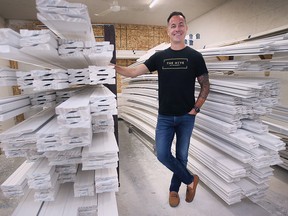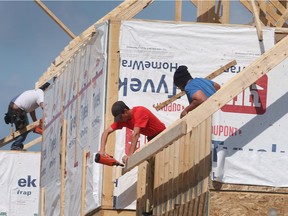
Article content
Windsor Essex Home Builders’ Association vice-president Brent Klundert said without major changes to the regulatory process and increasing the labor supply, it’ll be impossible to meet the Canada Mortgage and Housing Corporation’s goal of more than doubling new home construction by 2030.
advertisement 2
Article content
In a report released last week, the CMHC said Canada needs 3.5 million more residences to be built by 2030 in addition to the 2.3 million homes already projected to be constructed by that date in order to return affordability to the market.
“Even if we had all the zoned land and services to allow everyone in this area to double their output next year, we don’t have the trades and the people to do so,” said Klundert, who is also vice-president of BK Cornerstone Design/Build Ltd.
“We’re in such a shortfall position, I don’t know if that deficit can be made up unless something changes on the labor end of things.”
Klundert said Windsor and Essex County saw starts last year on about 1,000 residential builds, which also includes condos and apartments. That represented an increase of about one-third over 2020.
advertisement 3
Article content
“That was our (industry’s) best year locally,” Klundert said. “Right now, everyone is running fairly close to capacity.
“We’re pulling trades from London, which is also booming, and people are moving back to the area because it’s so busy.”
Western University economist Mike Moffatt, who is also senior director at the Smart Prosperity Institute, said last year was also a near record-year for home construction in Ontario. However, it was nowhere near the pace of construction required to meet the CMHC’s goals.
“In 2021, about 90,000 homes were built in Ontario,” Moffatt said. “That’s much higher than we have built in the past.
“Between 2011 and 2020 we built about 68,000 per year. We’d have to build 250,000 homes per year (to meet the CMHC target).
advertisement 4
Article content
“That’s not going to happen. That shows how far off we are to return to the affordability levels of 20 years ago.”
Ontario is forecasting construction of 750,000 homes over the next nine or 10 years. To reach the 2030 targets in the CMHC study, another 1.85 million residences would need to be built.

Moffatt said Ontario had been doing a reasonable job of balancing home supply with population growth until 2015 when several factors began to distort the picture.
The oil crash in Alberta caused many Ontarians to return to their home province, the federal government boosted immigration numbers, the number of those immigrants choosing Ontario as home increased, and there’s been a significant growth in the number of international students attending the province’s post- secondary institutions.
advertisement 5
Article content
Rising housing costs in large urban centers led to families moving farther away and the COVID-19 pandemic accelerated that exodus driving up prices across the province.
“We had a massive boom of 20- and 30-somethings coming to Ontario, but we didn’t change our planning processes or increase the number of homes we were building,” Moffat said.
Klundert said the solution to increasing housing begins with reducing regulatory red tape, having the municipal staff to handle the planning process and addressing the trades shortage.
COVID-19 has also created supply chain issues, he said, but that is expected to be a short-term problem.
“The red tape has filtered through all aspects of the building cycle,” Klundert said. “It’s resulted in a low inventory of residentially zoned land across Ontario.”
advertisement 6
Article content
He points to one of his firm’s parcels of residentially zoned land that has taken over 10 years to get developed while his father Ben, who founded BK Cornerstone, is involved in a project approval process that has surpassed the 20-year mark.
“That’s really how we got into this mess,” Klundert said. “We’ve focused too much on quelling demand and not enough on the supply side.”
We’ll have a whole host of societal and economic consequences
Moffatt said the scale of the problem will force governments to make other significant policy changes.
Changes such as encouraging more dense development in urban areas, tying development to transit systems, innovation to speed up building processes and reducing the need for more labour.
“It can’t be business as usual,” Moffatt said.
“There’s a role for governments to play, particularly in social housing, assisted living and the regulatory process. It’s also important to address affordable housing needs not provided by for-profit builders.”
advertisement 7
Article content
Moffatt added there are significant societal consequences for failing to improve housing supply and affordability.
Ontario is already seeing evidence that with more people leaving the province, a higher rate of homelessness, longer social housing waitlists and children living longer with their parents.
-
Erosion of housing affordability in Ontario during pandemic worst in five decades
-
Feds announce $20M in Windsor-Essex ‘rapid’ housing projects
-
Windsor summit hears of tiny homes, big dreams to end housing ‘crisis’
For the first time in 40 years Ontario had a negative net migration with Quebec with home prices a lure. The average price of a home in Quebec in May was $514,925 while in Ontario it was $940,485.
“Because they’re remaining in their parents’ home, people are waiting longer to get married and putting off having children,” Moffatt said.
“The fertility rate in Ontario has fallen below Alberta families and that was never the case. When they do buy a home, they’re often house poor and can’t save, invest and spend on other things.
“We’ll have a whole host of societal and economic consequences.”


